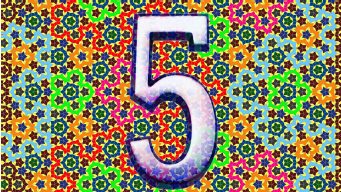
The first
one should be quite easy for everyone. After that they get harder,
but they're still meant to be expository and fun,
Here you can see videos of my talks — and also my slides,
which have links to references that fill in the details.
Different numbers have different personalities. The number 5 is quirky and intriguing, thanks in large part to its relation with the golden ratio, the "most irrational" of irrational numbers. The plane cannot be tiled with regular pentagons, but there exist quasiperiodic planar patterns with pentagonal symmetry of a statistical nature, first discovered by Islamic artists in the 1600s, later rediscovered by the mathematician Roger Penrose in the 1970s, and found in nature in 1984.
The Greek fascination with the golden ratio is probably tied to the dodecahedron. Much later, the symmetry group of the dodecahedron was found to give rise to a 4-dimensional regular polytope, the 120-cell, which in turn gives rise to the Poincaré homology sphere and the root system of the exceptional Lie group E8. So, a wealth of exceptional objects arise from the quirky nature of 5-fold symmetry.
Watch this video:
and for more detail, read the slides of this talk.
For example, superstring theory works in 10 dimensions because 10 = 8+2: the 2-dimensional worldsheet of a string has 8 extra dimensions in which to wiggle around, and the theory crucially uses the fact that these 8 dimensions can be identified with the octonions. Or: the densest known packing of spheres in 8 dimensions arises when the spheres are centered at certain "integer octonions", which form the root lattice of the exceptional Lie group E8. The octonions also explain the curious way in which topology in dimension n resembles topology in dimension n+8.
Watch this video:
and for more detail, read the slides of this talk.
which he obtained before Abel declared that "divergent series are the invention of the devil". Euler's formula can now be understood rigorously in terms of the Riemann zeta function, and in physics it explains why bosonic strings work best in 26=24+2 dimensions. The fact that
is a perfect square then sets up a curious link between string theory, the Leech lattice (the densest known way of packing spheres in 24 dimensions) and a group called the Monster. A better-known but closely related fact is the period-12 phenomenon in the theory of "modular forms". We shall do our best to demystify some of these deep mysteries.
Watch this video:
and for more detail, read the slides of this talk.
Tom Leinster designed some nice posters for these talks. Click on one and look at the tiny print at the bottom to see who created the images involved. For example, the poster for the number 8 features a Home Depot nickel number 8 atop John Stembridge's famous picture of the roots of E8:
You can also see some publicity material put out by the University of Glasgow, and an article in a Glasgow newspaper, The Herald. And if you want to see my latest favorite number, check out 42.
email: baez@math.removethis.ucr.andthis.edu